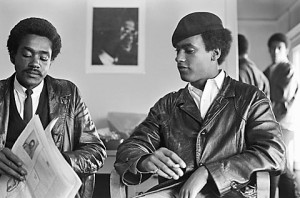The Black Panther Party (originally the Black Panther Party for Self-Defense) was founded on October 15th, 1966 by Huey P. Newton and Bobby Seale. Its founding came as a reaction against the social and economic inequality plaguing the lives of black individuals in the U.S. Many African-Americans were still facing health problems, housing problems, and violence from law enforcement officials even after the Civil Rights legislation of the 1960s. Knowing this, both Newton and Seale created a new revolutionary organization that “adopted a socialist way of approaching issues within a community,”(PBS, Formation). They began 35 community development projects or “Survival Programs” (like free children’s breakfast, Liberation Schools, etc.), patrolled black neighborhoods as to protect black individuals from police violence, and outlined a Ten-Point Program that aimed to reverse the negative effects of capitalism and economic oppression.

[Huey Newton (right) and Bobby Seale (left) at Black Panther Party headquarters in San Francisco]
It’s important to note, however, that the Black Panther Party did not really make their way onto the national scene until two major events in 1967. The first came on May 2nd, when twenty-nine armed Panthers disrupted a California State Legislature, protesting the Mulford Act, a gun control bill that would have made “carrying a loaded weapon within city limits a crime” (Jones, “The political repression…”). The Panthers claimed that this bill would interfere with their ability to patrol police in black neighborhoods. (Weapons were only used as a means of protection from retaliation). A few months later, on October 28th, tensions between the law enforcement an the BPs escalated, when a shoot out left a police officer dead and a wounded Huey Newton. Newton was soon charged with first degree murder, which eventually became a rallying point for the BPP.
Over the course of two years, the Panthers’ membership grew to over 2,000, with 32 chapters in 15 states and allies from abroad (Jones, “The political repression…”). This, of course, did not go unnoticed. The FBI, recognizing the group’s use of communist and socialist ideology, declared the Panthers an enemy of the government. They were eventually considered to be the ‘number one threat to the security of the United States’ (Jones, “The political repression…”). The government even devoted some of COINTELPRO’s resources (the FBI’s Counterintelligence Program) to completely disembowel the organization by 1969. The campaign against the Panthers eventually came to its height during a five hour shoot out at their Southern California headquarters and an Illinois state police raid that left Chicago Panther leader, Fred Hampton, dead.
Works Cited:
“Black Panther Party”. Encyclopædia Britannica. Encyclopædia Britannica Online. Encyclopædia Britannica Inc., 2016. Web. 23 Feb. 2016 <http://www.britannica.com/topic/Black-Panther-Party>.
“Formation.” PBS, n.d. Web. 21 Feb. 2016. pbs.org/hueypnewton/actions/actions_formation.html
Jones, Charles E. “The political repression of the Black Panther Party 1966-1971: The case of the Oakland Bay area.” Journal of Black Studies 18.4 (1988): 415-434 www.jstor.org/stable/pdf/2784371.pdf?acceptTC=true
Photo:
http://diaspora.northwestern.edu/mbin/WebObjects/DiasporaX.woa/wa/displayArticle?atomid=697